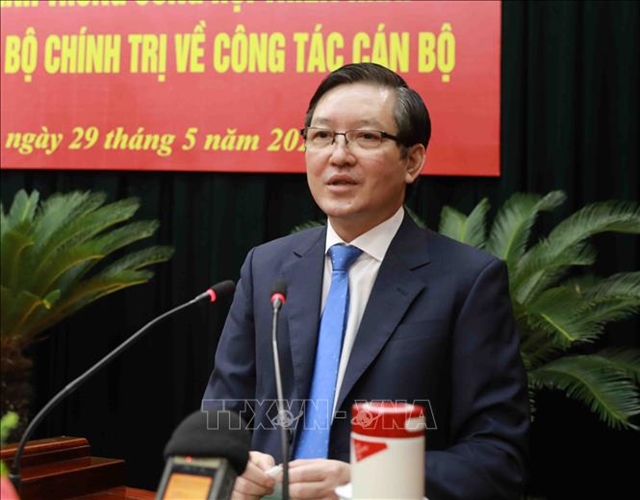 Opinion
Opinion


|
| Lương Quốc Đoàn, chairman of Vietnam Farmers’ Union. VNA/VNS Photo |
Lương Quốc Đoàn, chairman of Vietnam Farmers’ Union, talks to Vietnam News Agency about outcomes of the union’s emulation movement before the 6th national conference honouring outstanding farmers to be held on September 13.
Could you elaborate on the outstanding achievements of the union’s emulation movement over the past five years?
In spite of challenges, the movement of good farmers in production, business and solidarity helping each other to get rich and reduce poverty sustainably has achieved lots of good results.
That was thanks to the Party's leadership, the management and administration of the State and all levels, as well as proactiveness and responsibilities of all-level farmers’ associations.
The movement made an important contribution to stabilising the macro-economy, affirming the important role of agricultural production as the economic backbone, protecting national food security, especially during the COVID-19 pandemic.
Each year during the 2017-22 period, the number of members registering for the title of good farmers at all levels increased by 4.3 per cent on average. About 6.21 million members have made registrations, accounting for 53.4 per cent of the total number of farming households nationwide.
The quality and efficiency of the movement are improving day by day with an increasing number of farming households expanding their production, rising their business capital up to hundreds of billions of đồng, attracting tens and even hundreds of employees with annual incomes from hundreds of millions of đồng to tens of thousands of millions of đồng.
Compared to the previous period from 2012 to 2017, the number of households achieving the title of good production and business farmers increased by 60,000. Not only has the quantity increased, but the quality of good production and business households has also improved.
The number of farming households with an income of over VNĐ500 million per year has tripled.
The number of households with an income of over VNĐ1 billion per year has doubled.
How has the emulation movement contributed to agriculture, farmers and rural area development?
The movement was launched in 1989 by Vietnam Farmers’ Union. After 33 years, the movement has spread widely among Vietnamese farmers.
It has attracted millions of members and been highly appreciated by all-level authorities.
The movement is also a driving force promoting self-reliance, innovation, creativity in getting rich and encouraging farmers to overcome difficulties. Farmers have transformed their crop and livestock structure, exploited local potentials and strengths, invested and applied techniques, especially technology of the fourth industrial revolution in production to create the value of goods, high profits.
Good production and business farmers take the lead in reorganising and establishing new agricultural cooperatives and enterprises. Farmers’ associations have helped established more than 15,700 collective economic models. During 33 years since its launch, the movement has made significant contributions to poverty and hunger eradication, social security policy implementation in rural areas. It has also created jobs and increased incomes.
During the COVID-19 pandemic, farmers donated nearly 13,000 tonnes of farm produce as well as essential goods and cash worth VNĐ210 billion.
The movement makes an important contribution to the national target programme on building new-style rural areas, maintaining political stability, rural social order and safety as well as protecting national security.
Together with farmers across the country, every year, outstanding farmers of the movement donate more than VNĐ10 trillion and hundreds of hectares of land to build new rural areas.
The movement has officially become a part of the national target programme on building new-style rural areas in the 2021-25 period.
In the past five years, farmers’ associations at all levels have admitted more than 2.1 million new members, bringing the number of members nationwide to over 10.28 million, accounting for more than 70 per cent of farming households.
All villages with farms have established associations with more than 80,000 branches and over 143,000 associations.
Despite numerous difficulties, especially during the COVID-19 pandemic, the movement continued to achieve important results, contributing to the development of agriculture, rural areas, farmers, ensuring national and local defence and security, especially in the agricultural and rural areas.
This creates a foundation for accelerating industrialisation and modernisation of agriculture and rural areas and international integration.
What are the orientations and important plans for 2022-27 period?
Besides achievements, the movement still has shortcomings. The association has mapped out solutions to take advantage of potentials and address shortcomings in order to concretise the 13th National Party Resolution, Resolution 19-NQ/TW dated June 16, 2022 on agriculture, farmers and rural areas towards 2030, vision to 2045 and Resolution of the 7th Congress of the Vietnam Farmers' Union.
The union will renew the communication campaigns to disseminate Party, State and union’s policies to its members through practical activities.
All-level associations must step up supporting members in legal procedures, capital, vocational training, transfer of science and technology, and consumption of agricultural products.
The union must become a bridge, building trust between farmers and enterprises, cooperatives, scientists.
The union must gather good production and business farmers so that they will become the core factor of rural development, especially rural economy and the nucleus of collective economic development. VNS